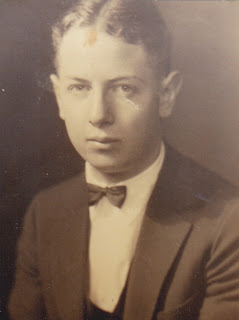Eunice Estella Scott
Roots
In the early 1600s, ancestors of Mummy’s moved from England to Massachusetts to a new land, then moved to Vermont, and finally Wisconsin. Mummy’s father was out west avoiding bears, then returned to farm on his father’s farm in Cazenovia, WI. Some highlights follow.
Early ancestors (on father’s side):
A relative of Ned Donaldson’s, in separate research, traced the descendants of King Edward I, and they included a simple farmer who bought land in Wisconsin to farm on from the government --- Mummy’s grandfather, Otis Brigham Scott! For fun, here is the data showing a mere 20 generations to royalty J …
1. King Edward I – 1239-1307 – and Princess Eleanor (Leonora)
2. Princess Elizabeth De Bohun
3. William De Bohun
4. Elizabeth De Bohun-FitzAlan
5. Elizabeth FitzAlan-Goushill
6. Elizabeth Goushill-Wingfield
7. Elizabeth Wingfield-Brandon – d 1497
8. Eleanor Brandon-Glemham – d 1480
9. Anna Glemham-Palgrave
10. Thomas Palgrave (Pagrave) – b 1505, in Thruxton, Norfolk, England
11. Rev. Edward Palgrave – 1540-1623, died in Barnham Broom, Norfolk, England
12. Richard Palgrave, d 1585-1651 in Charlestown, MA, was a physician (came to US in early 1600s!)
13. Anna Palgrave-Woodbury
14. Abigail Woodbury-Ober
15. Richard Ober
16. Ebeneezer Ober
17. Mary Ober-Warren
18. Grace Warren-Scott of Newfane, VT, married Zebulon Scott of Waterbury, CT
19. Otis Brigham Scott – 1824-1898 and was born in VT, but died in Richland Co, WI
20. Warner P. Scott – 1876-1946
21. Eunice Estella Scott-Buffam – 1911-1992
Eunice’s grandparents on father’s side:
Otis Brigham Scott, Nov. 8, 1825-Feb 25, 1898;
married Sally Ann McKune, July 7, 1836-May 24, 1906.
Children:
O. Wynfield Scott, 1861-1914,
Warner P. Scott, 1876-1946, m. Rosella McLaren, Feb 26, 1887-Oct 2, 1954.
Warren E. Scott, May 7, 1863-Dec 27, 1949, m. Caroline M, July 7, 1867-June 12, 1901
Ethnicity: Otis presumably British, Rosella McLaren, presumably Irish.
Location: The Otis B. Scott family lived on a farm in Loyd, WI. Otis purchased much of the farm in 1872, 79, and 90. It had been government land till 1854. Most of the above records are from the Loyd cemetery.
Stories:
Eunice’s grandparents on mother’s side:
William McClaren, Dec 30, 1857- Sep 9, 1941 (age 83 – of a heart attack)
m Mary Etta Fry, Sept 21, 1866-Aug 11, 1895 (age 28 – of consumption)
Children: Rosella 8, Bertha 6, Estella (Stella) 5 ½, Bennie 3, Jay 11 months (age at mother’s death)
Ethnicity: William presumably Irish (Mc), Mary Fry presumably German
Location: Rosella was born in Orion, Richland County, WI
Stories:
Rosella wrote about her mother Sally: “She worked too hard. Had too little and had too many children or too often. She had no sewing machine, no washer, no phone or nothing much to work with. She also had two miscarriages during the 11 years of her married life. She died when Jay was eleven months old. She would have been 29 the month after her death.” Rosella had to be mother to her 4 siblings.
James W. McClaren
Mummy’s parents
Warner Phineas Scott, 1876-1946, m. Rosella McLaren, Feb 26, 1887-Oct 2, 1954.
Children:
Dorothy Marion m John Gilbert Mortimer
Eunice Estella m John Cecil Buffam
Edith Wilma m Rodney Brown
J. W. Pershing m Opal Simpson
Marjorie June m Andrew Crawford
Ethnicity: Warner presumably Scottish, Rosella presumably Irish
Location: Loyd, WI
Stories:
Rosella: Rose raised her five brothers and sisters. She early showed great determination by preparing to teach school and taught several years. She was converted at a Free Methodist revival and was a sincere Christian all her remaining years.
Rose at Training School
A love letter from Warner to Rose:
My dear friend, tonight is Sunday night and I am at home alone and lonesome. I wish I were with you and I would tell you all about the wild woolly west. I am coming to R. C. one day next week and if you will write me telling me where I will find you, I will call on you and we can make arrangements for there fair (sic). Did you get the picture of that bear that got after me out west. Good night. I am your friend, Warner Scott.
Rose's strengths: had great determination and will. If she set her mind to do something, the others knew she would do it. Weaknesses: She was a diabetic and had to take insulin for a number of years.
Rose was a great worker. Besides working out in the field, she sewed dresses for the neighborhood children without a pattern. Her garden was the biggest and best in the neighborhood. She also raised all kinds of berries. She raised chickens, turkeys and honey bees. Because she had so much outdoor work to do, the daughters were given the work in the house to do.
Some old papers torn out of Grandma Rose's Bible
Edith did not marry the Rev. C. J. Buffam as the newspaper article says! Eunice did!
Grandma Rose died of heart failure from a blood clot that came from her broken hip.





.jpg)









.jpg)
.jpg)


.jpg)






